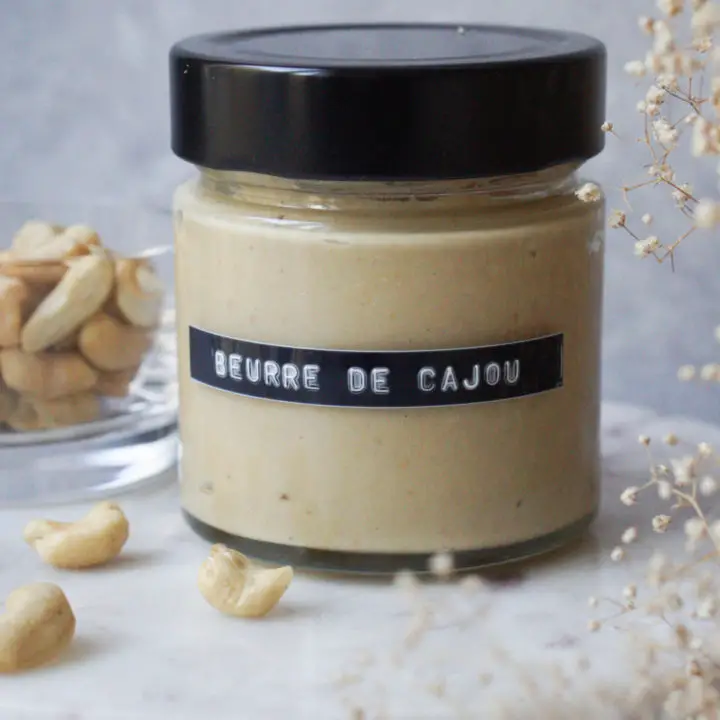If you’re a fan of nut butters, you’ve probably encountered the classics like peanut butter and almond butter. But have you ever tried the luscious and creamy cashew butter? This delectable spread is not only a delightful treat but also packs a nutritional punch that sets it apart from its peanutty counterpart. In this blog post, we’ll dive into the world of cashew butter, exploring its ingredients, benefits, and various uses, and we’ll also compare it with peanut butter to address the common question: is cashew butter better for you than peanut butter?
Video Recipe
The Ingredients
Cashew butter is a simple yet delightful concoction made primarily from roasted cashew nuts. Cashews are an excellent source of healthy fats, protein, dietary fiber, and essential minerals like magnesium, phosphorus, and zinc. Unlike peanut butter, cashew butter often contains minimal added ingredients, and some variations may include a pinch of salt or a dash of sweetener for those with a sweeter tooth.
How to Make Cashew Butter recipe


Making cashew butter at home is a rewarding process that allows you to create a pure and delicious spread without any added preservatives. To get started, you’ll need a few simple ingredients and a good food processor. Here’s a quick guide on how to make your own creamy cashew butter:
Ingredients:
- Raw or roasted cashew nuts (approximately 2 cups)
- Optional: A pinch of salt or sweetener to taste
Instructions:
- Select Quality Cashew Nuts: Choose high-quality raw or roasted cashew nuts for the best flavor and texture. If you’re using raw cashews, you may want to roast them in the oven at 350°F (175°C) for about 10-12 minutes until they turn a light golden brown. This step enhances the flavor of the cashews.
- Transfer to Food Processor: Once the cashews are ready, transfer them to a sturdy food processor. A high-quality food processor is essential for achieving a smooth and creamy consistency.
- Start Blending: Secure the lid of the food processor and turn it on. Initially, the cashews will break down into a coarse, crumbly texture. Be patient during this process, as it may take several minutes to reach the desired creaminess.
- Scrape Down the Sides: Pause the food processor occasionally to scrape down the sides with a spatula. This ensures even blending and prevents any cashew pieces from sticking to the edges.
Part 2
- Optional Additions: At this point, you can add a pinch of salt or a touch of sweetener like honey or maple syrup to enhance the flavor. However, this step is entirely optional, as some prefer the natural taste of cashews without any additions.
- Blend Until Smooth: Continue processing the cashews until the mixture turns smooth and creamy. The duration of blending will depend on the power of your food processor and the desired consistency. The key is to be patient and allow the cashews to release their oils, creating that luscious texture.
- Taste and Adjust: Once you achieve the desired smoothness, taste the cashew butter and adjust the seasoning if needed. You can add more salt or sweetener according to your preference.
- Store in a Jar: Transfer the freshly made cashew butter to a clean, airtight jar. It can be stored at room temperature for a few weeks or refrigerated for a longer shelf life.
Remember that the process of making cashew butter might take some time and require patience, but the final product will be worth it. Whether you spread it on your morning toast, blend it into smoothies, or use it as a dip for fruits and vegetables, your homemade cashew butter will surely delight your taste buds!
Is Cashew Butter Better for You Than Peanut Butter?
The comparison between cashew butter and peanut butter sparks curiosity among health-conscious consumers. While both are nutritious choices, they do have some differences that might sway your preference.
- Nutritional Content: Cashew butter boasts a higher monounsaturated fat content compared to peanut butter. Monounsaturated fats are considered heart-healthy fats that can help reduce bad cholesterol levels. Additionally, cashew butter contains a good amount of copper, a vital mineral that supports the body’s energy production and antioxidant defense.
- Allergies and Sensitivities: For individuals with peanut allergies, cashew butter can be a safer and equally delicious alternative. Peanut allergies are relatively common, and in such cases, cashew butter can be a better choice to avoid potential allergic reactions.
- Calories and Protein: While both cashew butter and peanut butter are calorically dense, peanut butter has a slightly higher protein content per serving. If you’re looking to boost your protein intake, peanut butter might be the go-to option, but cashew butter can still provide a wholesome dose of protein.
Ultimately, the choice between cashew butter and peanut butter comes down to individual taste preferences and dietary considerations. Both nut butters offer valuable nutrients, and incorporating a variety of nuts into your diet can be beneficial for overall health.
Is It Cheaper to Make Cashew Butter?
When it comes to cost, making cashew butter at home can be more expensive than purchasing a jar of peanut butter from the grocery store. The primary reason for this is the price of cashew nuts, which tend to be higher compared to peanuts. Additionally, cashews are softer and contain more moisture than peanuts, making the production process slightly more labor-intensive.
However, despite the higher price tag, many homemade cashew butter enthusiasts find the process rewarding and cost-effective in the long run. By making cashew butter at home, you have control over the ingredients, allowing you to create a pure and wholesome spread without any added preservatives or excessive salt and sweeteners.
What Is Cashew Butter Used For?
Cashew butter is a versatile ingredient that can be utilized in a multitude of ways, making it a kitchen staple for many households. Here are some popular uses for cashew butter:
- Spread: The most common use of cashew butter is as a spread, just like peanut butter or almond butter. Slather it on toast, crackers, rice cakes, or even fruits for a delicious and nutritious snack.
- Baking: Cashew butter can add a rich, creamy texture to baked goods like cookies, brownies, and cakes. It can also serve as a vegan replacement for butter in certain recipes.
- Smoothies and Shakes: Adding a spoonful of cashew butter to your smoothies or shakes can enhance the flavor and provide a boost of healthy fats and protein.
- Sauces and Dressings: Cashew butter can be the secret ingredient to create creamy and delectable sauces and dressings for salads and pasta dishes.
- Dips: Whip up a savory dip by combining cashew butter with herbs, spices, and other seasonings. It pairs perfectly with vegetable sticks, pretzels, or pita bread.
Is Cashew Butter Recipe Anti-Inflammatory?
Cashews, the primary ingredient in cashew butter, contain various nutrients with potential anti-inflammatory properties. These include antioxidants like vitamin E, as well as minerals such as zinc and copper, which play roles in immune function and reducing oxidative stress. However, it’s essential to note that cashew butter, like most foods, is just one component of a balanced diet. A diet rich in a variety of fruits, vegetables, whole grains, and healthy fats can collectively contribute to an anti-inflammatory effect in the body.
In conclusion, cashew butter is a delicious and nutritious nut butter that can be a worthy addition to your pantry. It offers a unique flavor profile and a different nutritional composition compared to peanut butter, making it an excellent option for those seeking variety in their diet. Whether you choose to buy a jar from the store or embark on a homemade adventure, cashew butter is sure to win hearts and taste buds alike!
You can also try
Try adding some cashew butter to your smoothie like this one
Which Food Processor for the cashew butter recipe?
I love this Vitamix Food processor.
Cashew Butter Recipe
Cashew Butter Recipe Homemade


If you're a nut butter enthusiast seeking a velvety and nutritious spread, look no further than homemade cashew butter. With its rich, smooth texture and delectable taste, cashew butter is a delightful addition to your pantry. In this quick and easy recipe, we'll show you how to create this creamy treat, requiring just a few simple ingredients and a touch of patience. Get ready to elevate your taste buds with the wholesome goodness of homemade cashew butter!
Ingredients
- Cashew Nuts ( 2 cups )
Instructions
- If using raw cashews, roast them in the oven at 350°F (175°C) for 10-12 minutes until lightly golden.
- Transfer the cashews to a food processor.
- Blend until the cashews turn crumbly.
- Scrape down the sides of the processor.
- Continue blending until the mixture becomes smooth and creamy.
- Optionally, add a pinch of salt or sweetener to taste.
- Blend again to incorporate the seasoning.
- Transfer the cashew butter to an airtight jar.
- Enjoy as a spread, in smoothies, or as a dip! Store at room temperature or in the refrigerator.
Notes
Feel free to experiment and add your own twist to the recipe by incorporating flavors like vanilla extract or a dash of cinnamon. These delightful variations can elevate the taste and open up a whole new world of possibilities for your cashew butter creations. Get ready to elevate your taste buds with the wholesome goodness of homemade cashew butter!
Did you make this recipe?
Don’t forget to share on your socials and tag @maryabenzakour













1 Comment
[…] Cashew Butter Spread […]